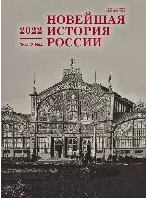Реакционеры, черносотенцы, белогвардейцы, фашисты: дефиниции русского правого лагеря начала XX века
Reactionaries, Black Hundreds, White Guards, Fascists: Definitions of Russian Right-Wingers in the Early 20th Century
Author(s): A.A IvanovSubject(s): Governance, Military history, Pre-WW I & WW I (1900 -1919), Interwar Period (1920 - 1939), History of Communism, Fascism, Nazism and WW II, Geopolitics
Published by: Издательство Исторического факультета СПбГУ
Keywords: right-wingers; conservatives; reactionaries; Black Hundreds; right-wing revolutionaries; White Guards; fascists; Russia;
Summary/Abstract: : The article presents a detailed analysis of definitions that, having arisen during the political struggle of the early 20th Century, subsequently became entrenched in historical literature in relation to the right-wing monarchist movement. Special attention is paid to the circumstances of the emergence, use and validity of such terms as “conservatives”, “reactionaries”, “rightists”, “the Black Hundreds”, “bison”, “the Whites” (“the White Guards”), “right-wing revolutionaries”, “fascists”. It is for the first time that the author has introduced to scientific community the sources illustrating how certain definitions were used in relation to Russian right-wingers in the periodicals and journalism of pre-revolutionary and Soviet Russia and the reaction to them from the Black Hundreds and Russian nationalists. The article shows that the same terms and definitions could have different interpretations and be endowed with opposite characteristics when used by opposing political forces. Such nicknames as “the Black Hundreds” and “bison” sounded like swear nicknames in the mouths of the members of the revolutionary and liberal camps. However, some right-wingers proudly raised them to their banners. At the same time, the monarchists rejected the nickname “right-wing revolutionaries” in every possible way, since they saw it as a tool for discrediting and distorting their political goals. The later term “fascists”, retrospectively applied to the Black Hundreds by their opponents, inspired in some of their former leaders a desire to present the pre-revolutionary movement of Russian monarchists as genetically close to the European right-wing movements of a later time. Attention is also paid to the little-known term “the Whites” (“the White Guards”), which was used in relation to the right-wing camp during the First Russian Revolution, but later was supplanted by other nicknames and almost forgotten.
Journal: Новейшая история России
- Issue Year: 12/2022
- Issue No: 41
- Page Range: 884-905
- Page Count: 22
- Language: Russian

